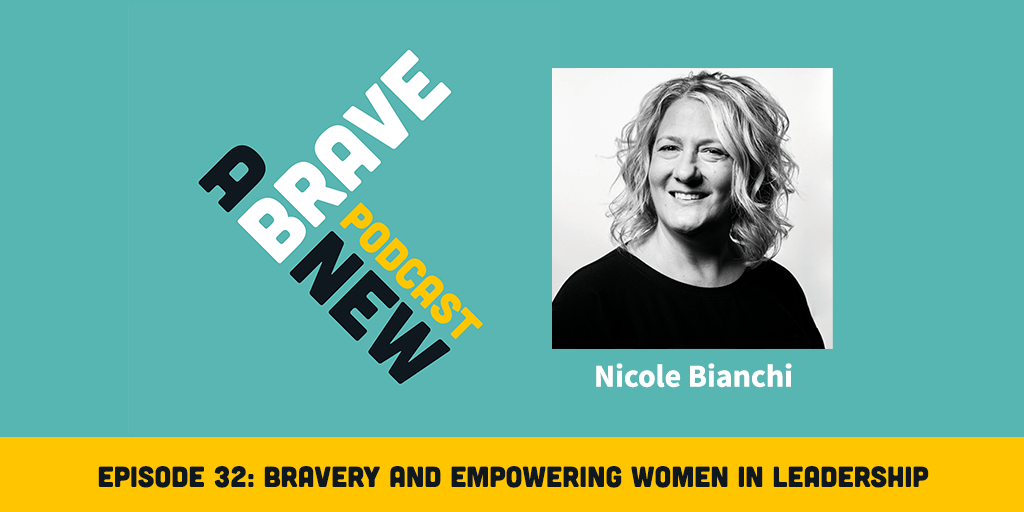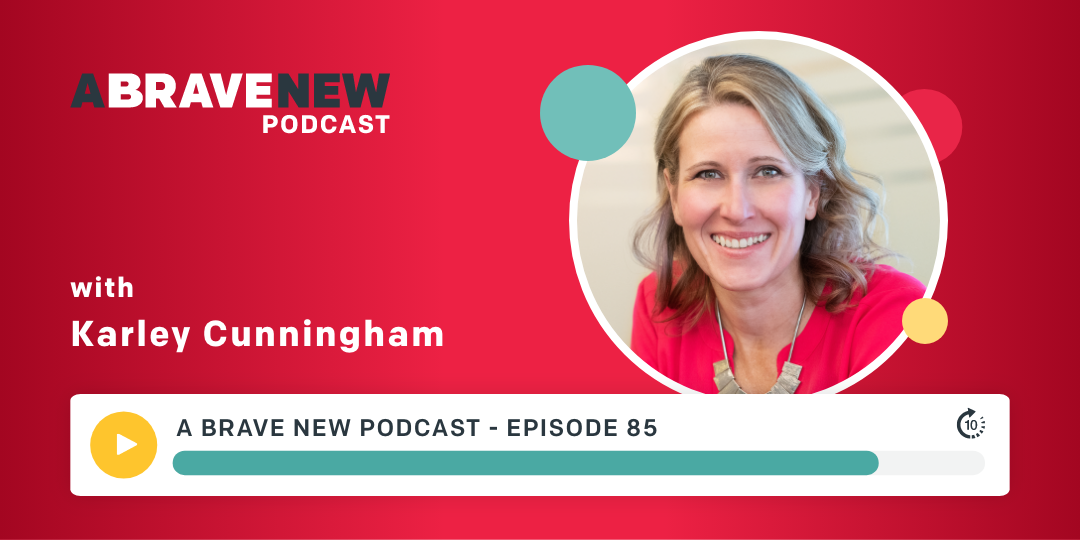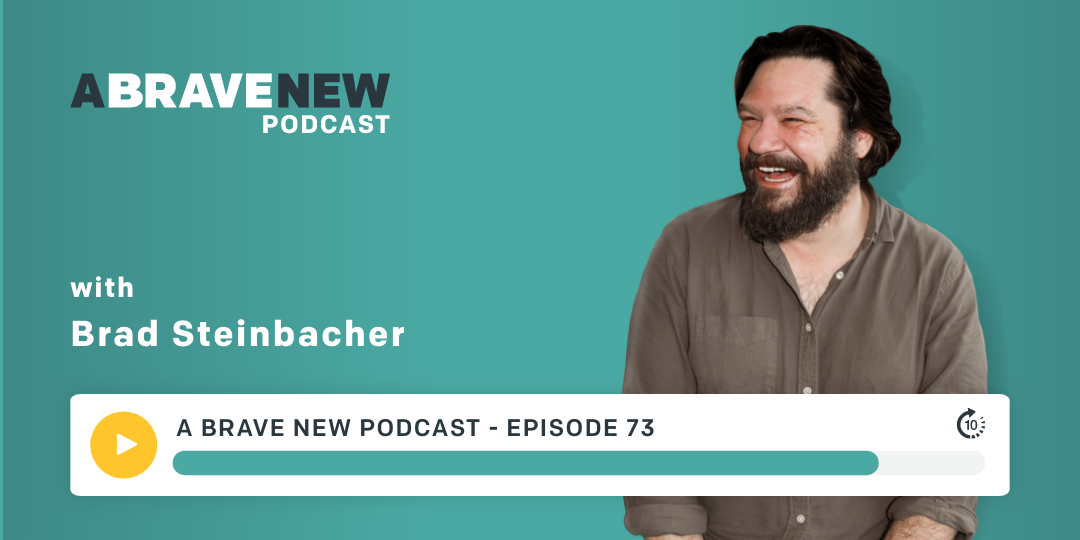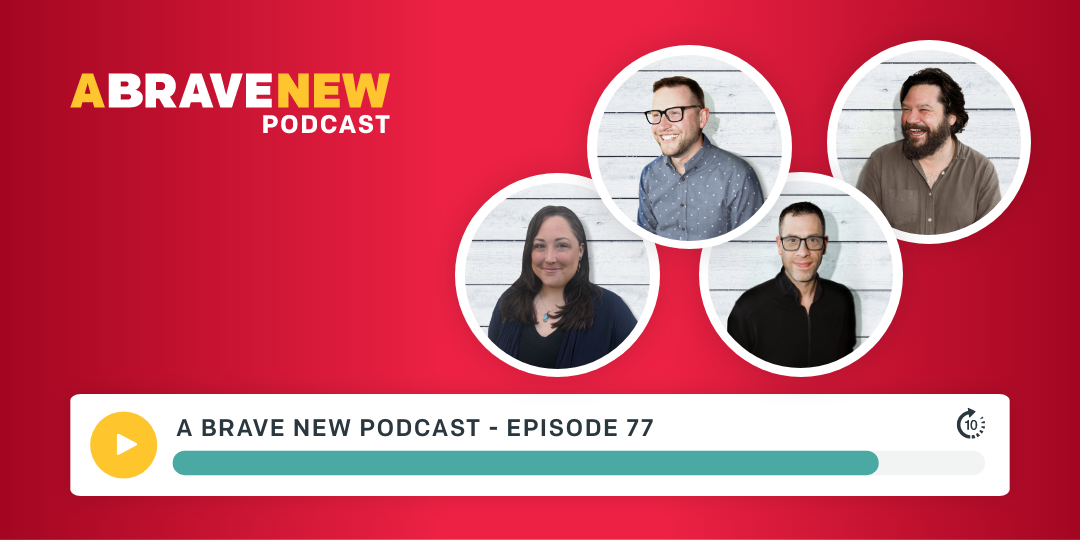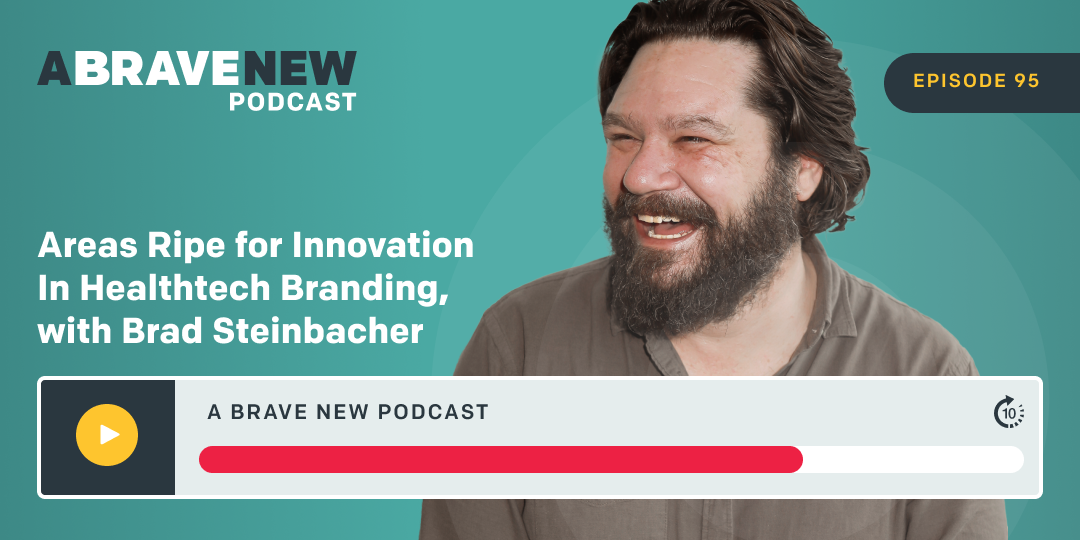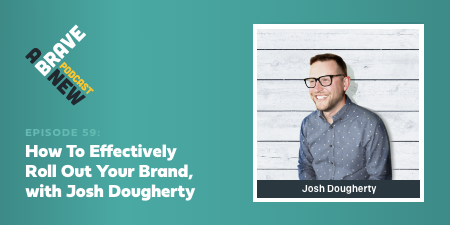Josh Dougherty is a brand strategist, speaker, and the founder and CEO of A Brave New, a Seattle-based B2B branding, content strategy, and design agency specializing in helping tech and healthcare brave, bold, and memorable brands. Over the last decade plus, he’s worked with clients to develop unique brands and accelerate business growth.
What you’ll learn about in this episode:
In this episode Josh discusses the importance of a well-managed brand rollout and eight mistakes to avoid during that rollout. The mistakes he discusses include:
- Rolling out your brand with legal issues unresolved
- Rolling out with key parts of your brand in wet cement
- Moving forward without having your messaging fully defined and dialed in
- Losing interest in the brand rollout before 18 months to 3 years has passed
- Allowing short-term pressures, like quarterly sales goals, dictate strategic direction
- Letting ease dictate decisions
- Forgetting the customer in your brand rollout decisions
- Committing less than 100% to the brand direction
As Josh discusses each of the mistakes, he shares stories about past branding projects and explains how to avoid each mistake.
Additional resources:
Transcript
Josh Dougherty:
Welcome to A Brave New Podcast. This is a show about branding and marketing, but more than that, it's an exploration of what it takes to create brands that will be remembered and how marketing can be a catalyst for those brands’ success.
I'm Josh Dougherty, your host. Let's dive in. Hello and welcome to the show today, I'm happy to have you along. Today, we're going to have a conversation about brand rollout. And if you've thought about your brand for a while or if you're thinking about doing a brand refresh, there's always a ton of excitement around creating the concepts behind the brand. We like to do the research and talk to our customers, understand why they love us, what they're most excited about. We like to think through what are those key concepts, the essence, the promise, the way people are going to connect with our brand.
And we like to go through and develop the concepts behind the brand and then the visuals. And then, typically, that takes some time and it takes a lot of effort. And you've built out maybe a brand book and you've talked about how to launch your brand, but then you get into the rollout phase and all of a sudden you lose momentum, you lose oomph. And the truth is that this rollout phase is the most important part of the branding process because it doesn't matter how strong the concepts you've created are. It doesn't matter how valuable or important or even break through those concepts are. It doesn't matter how beautiful the visuals you've developed are and your visual identity. If you don't roll it out well, it's not going to work. So today I want to spend a little bit of time talking about the mistakes to avoid when rolling out your brand.
And unfortunately, many of these lessons that I'm going to share, I think there's eight specific ones, are driven from actual experiences rolling out brands with other clients that we've worked with, et cetera. Because so often this is when the stop-start begins. And so I'm hopeful that as we go through these eight lessons, you can learn from the mistakes of others that maybe have gone through these. And I'm not going to call anyone out by name because I don't want to call anyone out and draw any blame there. Things happen and it can be challenging. But I do want to hopefully share these lessons so that you can have your brand rollout go smoother than maybe others have in the past. So let's dive in without any further ado. And I think the first one that I want to talk about, the first issue to avoid is deciding to roll out while legal issues are unresolved.
So the most common areas in a branding process where legal issues will be involved are typically in a couple places. First, with a brand name, if you've come up with a brand new brand name or refreshed your brand name. And the second is with logo marks, what's typically called your brand identity. These are both things that because of the quantity and number of clients or companies that exist in the United States and around the world, a lot of names have been taken, a lot of logos have been used. And not only that, there's often trademark or copyright issues if you have a logo or a name that is close or similar to someone else that's in your market space, et cetera.
And so it can be tempting to say, "You know what? We've done some cursory looking. We've gone through our ... maybe done some reverse lookup of images in Google. We've done a little bit of Googling to see if any names exist that are similar to ours. We may have even gone into the trademark office and looked through the directory to see what trademarks exist, but we haven't maybe done a full legal review to understand, can we get the trademark on the name we're using? Can we get the trademark on the logo mark we're using?"
And maybe that search has brought up a couple possibilities that might be problematic, but instead of doing that due diligence, going through the process with a legal team who specializes in IP and trademark as you should, you decide, "You know what? We're going to let them do that on the side, but we're going to continue to roll out because we're confident that we can work issues out down the road." And this is probably the biggest mistake you can make because the nightmare would be after you do all the effort of a brand launch, you start to flip over your website, to flip over your marketing collateral, to flip out over all these other things, and all of a sudden you get the letter that you were hoping you wouldn't get, a cease and desist from someone.
You're presented with an injunction. You may even go to court and you have to change your name or change your logo mark after you put all this effort into rolling it out. And then you have to do something worse. You have to either start the process over by coming up with a new name or a new logo mark, and then going through that launch and somehow explaining to the market, the industry you're in that you're changing your name for a strategic reason, not just because you were sued or you have to fall back to the brand that you previously used. And this is also a difficult thing to explain. So regardless of what the end outcome here is, the main lesson to take away is that you should wait until at least you've had your preliminary legal review to know that you're pretty confident that you're in the clear that you're not going to have rename yourself or change your logo.
I've had clients that have gone through this process and the amount of consternation and stop-start it creates when there's actual legal issues that arise can be paralyzing for the brand. It stops you from thinking strategically. It stops you from moving out and making a huge impact. So that's number one. Don't roll out your brand with legal issues that are unresolved.
Mistake two is rolling out ... is maybe similar but with less legal implications. And this is the idea of making sure that you don't roll out with your brand in wet cement. Now, many executives want to push quickly right? They want to get something into market and they want to get into market as quickly as possible because that will allow the work that's been done on the brand to start to be converted into ROI, into better differentiated market position, et cetera. But there are limits to this.
It's really easy to go through and redo your visuals, redo your colors, redo different things like that. But oftentimes the more difficult thing is to get through your brand research process and to land on those key concepts behind your brand, your essence, the thing that makes you unique like that item of clarity from our client, Redapt, the unique kind of magic sauce that they have. It's important to ensure that you have your promise nailed down as well—that promise you're making to your customers with each and every interaction. Now you can maybe say, "We're going to allow our personality to evolve over time. We're going to allow the ways that we live out the essence to evolve over time. We're even going to allow the benefit ladder, the way we're architecting the emotions around the relationships that we want to build, we're going to let that evolve and test with it."
But you need to have at least your essence and your promise in stone so that you can tell a consistent story regardless of how the other things change. Because if you have that key idea, that unique idea at the center of your brand firm, there's room for a lot of adjusting. But if you don't or if there's disagreement internally about how that should be positioned, it's better to wait until everyone in the organization can push through and roll that out confidently, stand behind it, not undermine it, not try to rethink it because that core essence or that core idea at the center of your brand, the unique way that you go about your work is the key thing you're going to try to communicate with consistency, so you don't want it to change over time. So that's item two. Don't roll out your brand with wet cement around the key concepts like essence and promise.
And related to that, I think it's also important to not move forward without your messaging being dialed in. This is the third item. The third mistake to avoid is moving forward without your messaging dialed in. Because even if you're going to iterate on that message, one of the key things that branding does is it allows us to communicate the unique approach that we have in a consistent and meaningful way so that customers and partners and now the other people we interact with are hearing from our sales reps, our marketing teams, our internal teams, customer success, all the people that are involved in telling your story, they're hearing the same story. And so even if you're going to iterate on your messaging over time, you need to roll out initially with a script that's the same for all those people, and that's maybe customized for their area of business because sales will talk about different things and customer success than marketing, but they're all to have the same messaging pillars that they're communicating.
This is essential for building that consistent unaided recall and the connection that we want to build between our customers and our brands. Now, you can evolve that over time from what you learn, kind of trying out new ways to convey your essence, new ways to convey your promise. But the key here is whenever you're going to evolve that, you need to get all of your organization on board with evolving that messaging, not having marketing go rogue or sales go rogue and talking in a different way. Because the key to branding right after we've developed the breakthrough idea is kind of boring. It's the consistency of saying the same thing over and over again so that people will remember it and start to build emotional affinity to who you are and how you show up in the world. And that brings me to the fourth real mistake to avoid when rolling out your brand.
And this is losing interest before enough time has passed. Now, if you've worked on a marketing team in the past, or if you've worked in a C-suite in the past, you know that boredom about repetition can set in quickly. But this again, as I mentioned as we were talking about making sure you're having your messaging dialed in, is really important to avoid because we know that it takes 18 months to 3 years for someone to start repeating something back to us without us prompting it. We also know it takes people 8 to 10 times, they need to hear a message 8 to 10 times before they really internalize it. And so it's vital that as a brand rollout team, we don't lose interest in conveying the core concepts of our brand until enough time has passed. And why do I say this? Why am I making this an individual point?
Because no doubt, in six months after the brand launches, someone's going to come up with an amazing campaign idea in the marketing team, and everyone's going to look around in that meeting. I've been in these meetings before and say, "Oh, man, we have been saying the exact same thing over and over and over again. And certainly we're fatigued of it and our customers must be fatigued of it as well. So this campaign feels new, it feels fresh, it feels exciting, let's do it." And what I would say here is don't fall into this trap. New, fresh, exciting here is the enemy of what you're trying to achieve, which is lasting market differentiation through consistent communication about who you uniquely are and why that uniqueness is valuable to your customer.
Say it again. The new flashy campaign is the enemy of what you're trying to do with the brand, which is to create a consistent message, a consistent message about who you are, why you're unique, and why that uniqueness matters to your customer. And here's the truth of all of it. We talk about this all the time with people. We talked about this with my team, I've talked about this with Polly, my former business partner many times. Your customers aren't in this as deep as you. Don't lose that perspective. And while you have been repeating this message over and over and over again, so you've been looking at it maybe on the screen, you've been talking about it, you've been seeing it numerous times a day, most of your customers haven't even noticed yet that you've changed your brand positioning. They may have seen one or two things, maybe they've opened an email, maybe they've watched one video, but they're still getting used to the new you.
And so you've got to give them time to catch on. You aren't the most important thing in their life, you may be the most important thing or a valuable thing for one of the areas of their life, especially if you're in the B2B healthcare technology space that we work in a lot. People are relying on you for one thing, typically. So their day is full of all these other things, and they only think about you when they're doing maybe one specific task or when they're going through research for a new vendor. So you've got to be patient. Understand that your boredom and even sometimes your disgust about saying the same thing over and over again is a good sign. It means you're doing the right thing because it might mean that your customers are starting to see you differently. They're starting to notice that positioning that you're trying to communicate. So item four, don't lose interest before enough time has passed. Stay consistent.
The fifth mistake I want to walk through to avoid when you're rolling out your brand is allowing short-term pressures to dictate decisions or changes. This is another classic thing that happens, right? Because in businesses and in sales, we often operate in fiscal years and quarters and there are goals and there are revenue pressures, and I won't spend a lot of time here, but there is no doubt in those first year, two years as you're working on rolling out your brand when people will say, "You know what? I'm hearing ..." a salesperson will come up and say, "I'm hearing from my customers this. They really resonate with this. I think our whole positioning should change to this." Or someone in operations might say ... this is we ... our marketing ops or sales ops is saying, "You know what? Our close rate has dropped a little bit, so we need to change our message because it seems like we're closing based on this other message or based on this other approach, or sales play," et cetera. It can also happen in marketing where you've maybe begun to optimize something in it, you get a signal that maybe something else is working.
Now, I am all for optimizing approach and ideas and concepts, but we need to remember that if we're going to optimize, we need to do it within the realm of the brand filter that we've come up with and ask ourselves, "As we optimize, are we staying true to the essence that we've decided on painstakingly? Are we staying true to our brand promise?" Because these are things that should be lasting beyond the sales pressures of the quarter or the marketing KPIs we're trying to drive for the year. We need to stay focused on the long-term. So don't allow short-term pressures to dictate decisions or changes. Stay true to the course because we're trying to build long-term safety and security for your organization by freeing you from the pressure of cost competition, by redefining your category, by building a consistent ... curating a memory in your customer's minds that will keep them coming back and buying. It's going to take time. So you need to be able to manage through the sales pressures, work hard to achieve the sales goals, the marketing goals as you're going, but not sacrifice the brand at the altar of those goals.
And this leads me to the sixth mistake to avoid. And this is letting ease dictate your decisions. Now, what do I mean by that? We've rolled out a brand. We're talking about how the implications can go out throughout the whole organization, and all of a sudden you start feeling pushback. Maybe it's from operations about how this change is going to be too hard. Maybe if it's from development that we can't change our development sprints or adjust our sprints to be able to deliver changes in our app that we need to make.
Maybe it's from your design team that we don't like these colors. We want to change things and go back to the colors that we liked more before. Change isn't easy. All of this pushback is natural, and I think it's essential that we show up with empathy and listen and work hard to reduce the real pain that these people are feeling in the midst of the change. But also be empathetic to the fact that many of the people who are starting to now realize the implications of what it means to roll out a brand completely. All of a sudden they haven't been through the same journey you've been. They haven't been through the brand research, they haven't been through the concepting. They haven't been through developing the brand drivers or developing the new visual identity. They haven't understood yet what the long-term impact of this branding exercise is going to be.
And so it's imperative because these people haven't been on the same journey as you to have positive regard and show empathy and have the patience to explain why we're going through this process, explain what's happening, and then try to make it easier for them. But at the end of the day, also understand that operational teams are always going to push for what is the easiest path because they're thinking of the day to day. They aren't thinking of the strategic long term. They're thinking of how we accomplish our goals for this week, next week, next month. And so as you interact with them with empathy, as you bring them along, as you explain to them why things are being done, you need to not give in. Do not compromise your brand and the impact of your brand for ease. Do not compromise the impact that your brand can have for ease.
It's going to be hard work, and it's essential, hopefully, to have your C-suite behind you to provide that executive buy-in that that hard work is worth it in real time and real money in order to build the long-term differentiated space or position in your market. And why don't we let ease dictate decisions? Because the brand does not exist for you. It does not exist for your internal teams. It does not exist even for your C-suite. It exists for your customers because a brand is about building affinity in your customers. It's about creating a memory or curating a memory of you in their minds so that they will purchase from you again and again. And so that's why not only do we not want to let ease dictate our decisions, but the seventh thing we'll talk about here is making sure that our decisions are only in service of the customer.
And I talk about this a lot in other stuff, and if you've listened to the podcast before, if you've read stuff I've talked about or read other things I've written, if you've seen my keynote before, I speak about how your brand is only as important as the memory it creates in your customer's mind. And the reason I say this is because at the end of the day, your brand exists in your customer's mind. It's an intangible thing. It's a valuable intangible thing, but it is intangible. And it doesn't matter how much we say about us or how much we communicate about who we are, what makes us unique, why we're special as a brand. But at the end of the day, the only part of our brand that's real is that memory that exists in our customer's mind. It's the thing that drives them to talk to you.
It's the thing that drives them to make a purchase or repeat purchase or stay with you. It is made up of emotional connections. It's made up of concepts, it's made up of feelings. And so no one else's feelings, no one else's opinions, no one else's concerns really matter. And I'm talking about your CEO, not marketers, not CEOs, not internal teams. We need to only do what will build connection and trust with the customer, period. And that is hard and challenging, but this is what you have to talk about as a brand over and over again with your people.
So as we close this out, I want to talk about the last thing, the last mistake to avoid when rolling out your brand. And that's not fully committing. This is, again, something that can often happen. You may have ... let's look at the things we've talked about so far.
You've gone through ... hopefully you've gone through and avoided any ... leaving any legal issues unresolved. You've made sure that you aren't rolling out with wet cement. You have your essence and your promise nailed down. You've defined your messaging. You're not going out without your messaging dialed in. You have some messaging you're going to use. You're focused on the long-term. You know it's going to take 18 to 30 months to get your brand rolled out. You are having the hard conversations with people when short-term pressures arise, so they keep their eyes focused on that long-term horizon, that long-term value we're building. You are having those empathetic and difficult conversations with internal teams when they're trying to make this a little bit easier, but you're sharing with them why it's essential that we do it the way we're doing it, that we continue and be focused on the brand rollout even though it creates extra work.
And then you're making those decisions in service of the customer. If you've done all those things, you're gotten pretty far. But the last mistake can kind of scuttle all that good work if you're not fully committed, if you choose to fight with two hands tied behind your back by ... and what I mean by this not fully committing is not putting the full money and effort of your organization, your company, behind this brand concept, just saying, "Hey, this is a marketing campaign" or "This is a marketing and sales thing. We're not going to look at how this changes our app experience or our platform. We're not going to look at how this changes our HR experience or how this changes customer success interactions. We're not going to look at how our documentation might need to shift through this. We're not going to look at how our presentations might change, or even our accounting systems might change."
This is really just about marketing and sales. And that couldn't be further from the truth because a brand has to ring true from every single layer of your organization so that whenever a customer interacts with you, no matter what part of the company that is, they're getting a consistent experience. Otherwise, you'll end up with an ineffectual brand that is just a face on the front of your company. But as soon as someone pushes through that initial marketing or that initial sales conversation, they realize that the rest of it isn't true. And nothing could be worse than that because imagine if you had the conversation that I had. I mean, about a decade ago, I was working with an organization out of Oklahoma City. We'd spent two years on a brand. I'm sitting with the marketing team and doing brand training, and one of the lead designers leans over at me and says, "You know what? This is all lip service. Nothing's going to change internally."
And he was speaking the opinion of many people through the organization. They had changed their look and feel, they had changed their messaging, but it was only a marketing campaign. And because everything else didn't change, the people didn't get behind the change in brand, and therefore the impact was less than it could have been. And that is a tragedy when you've gone through all the other work. So I'm going to wrap it up there. I hope this has been a valuable conversation. I hope this is giving you some of the contours of what to look for if you're headed towards a brand rollout, to make sure that you don't roll out and make a simple mistake that can be born out of good intentions, but can have drastic implications on the impact to the brand that you're building.
And if you ever want to talk more about this, feel free to reach out to me on LinkedIn, send me an email, and I'd love to have more conversations here because this is where the magic is made, right? A good brand rollout is where the impact happens. And so it pays for us to not only avoid these mistakes, but move forward with confidence, purpose, zeal, even when it gets hard, so that we can, at the end of the day, see the impact that a brand has in safeguarding the future of the company that we work for and the company we lead. And with that, I'll bid you adieu. See you next time. Cheers.
Thanks for listening to this episode of A Brave New Podcast. Go to abravenew.com for more resources and advice on all things brand and marketing. If you enjoyed this episode, show us some love by subscribing, rating, and reviewing A Brave New Podcast wherever you listen to your podcasts. A Brave New Podcast is created by A Brave New, a brand and marketing agency in Seattle, Washington. Our producer is Rob Gregerson of Legato Productions.



